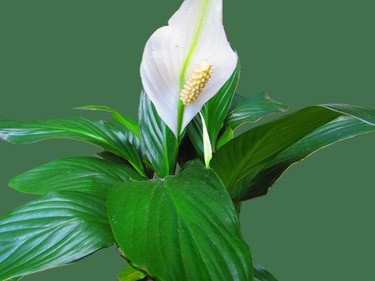
The beautiful peace lily (Spathiphyllum wallisii) looks like a classic lily, with its glossy green leaves and white flowers. Though not a true lily, this flowering tropical plant is associated with lily-like significance, including peace, love, compassion, healing, and hope. Even more important, a peace lily is undemanding, has no picky care requirements, and tolerates drought, humidity, and low-light conditions well.
Peace lilies thrive outdoors only in temperatures similar to their Central and South American native range, but they make exceptional houseplants anywhere and everywhere.
Video of the Day
Video of the Day
Peace Lily (Spathiphyllum wallissi) Highlights
- Easy Care: Yes!
- Light + Location: Indirect sunlight to low light
- Watering: Water consistently during the growing season when soil has dried out
- Growth Rate: Moderate
- USDA Zones: 11 to 12
- Flowering: Tiny yellow flowers on a spike, backed by
white "flowers" that are actually specialized leaves, or bracts, which hood the flowers
- Pet-Safe: No! Toxic to dogs and cats.
All About the Peace Lily
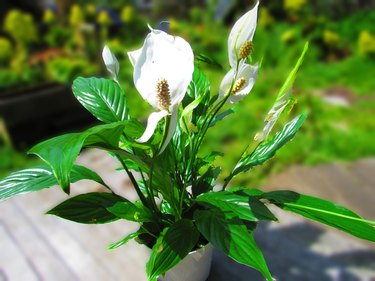
Now's the time for a peace lily! Mine almost always flower around Easter, offering a sense of serenity that seems perfect for the season. But that's not all to love about this great plant. The shining oval leaves are a vibrant shade of green and grow in a clumping growth habit—up to 16 inches tall—that makes for an attractive foliage plant even without the flowers.
But the blossoms are what make this plant magical. Each flower spike is backed and hooded by a glowing white spathe that looks like a white flag of truce. My plants flower in spring and again in midsummer, with the blossoms lasting a month or longer.
Types of Peace Lily Plants
I have never seen a peace lily I didn't like. Consider experimenting with popular varietals. What do they offer? Differences in height—from tiny to tall—and differences in size. Some plants have leaves up to 9 inches wide, while others grow leaves up to 20 inches long. Here are a few cultivars to try:
-
'Little Angel': Small and lovely, this dwarf varietal features glossy leaves and lots and lots of small white flowers.
- 'Sensation': Is bigger better? This glorious peace lily cultivar has broad, 20-inch leaves, and the plant can grow taller than you are.
- 'Starlight': This varietal offers narrow leaves that have wavy margins. It's also known for having multiple blooms, with as many as 20 flowers on a single plant.
- 'Picasso.' Lovely peace lily leaves offer great variation in amazing shades of white and light green.
Care and Feeding of a Peace Lily
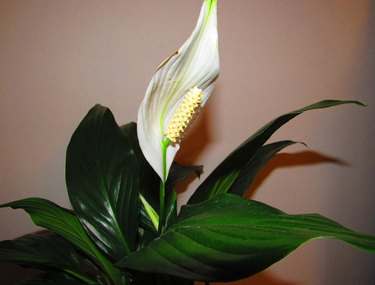
For all its elegance and grace, the peace lily is one tough plant. It requires little fuss as long as it gets a few basic needs met. Keep in mind that peace lilies grow in nature on the floor of rainforests in Central and South America. That gives you a clue to their care requirements: dappled or indirect sun, moist but not wet soil that drains well.
Because the peace lily can live in low-light conditions and tolerates some drought, it's a perfect choice for someone just getting into houseplants. Here's a recap of the care that helps a peace lily thrive.
Best Location for a Peace Lily
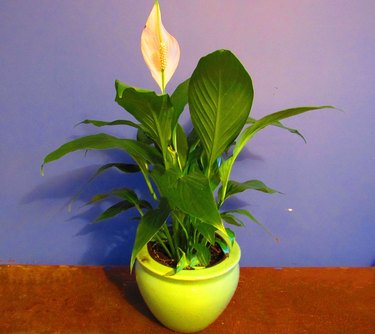
If you don't happen to live in a tropical rainforest, you won't be able to mimic the peace lily's natural setting. Still, keep it in mind as you decide which windowsill would work best. Select a window that gets bright, indirect light. Eastern windows work well, as will any window with a tree just outside to dapple the sunlight coming in. Direct sun can crisp the leaf tips.
So what about the peace lily being a low-light plant? If you're like me, you have at least one room that gets precious little natural sunlight. I do keep a peace lily in this room, but I consider it a foliage plant, brightening the atmosphere with its glossy leaves. The plant simply doesn't flower without some sun. If you feel guilty about this, just get two peace lilies and swap their locations every six months or so.
Potting Soil for a Peace Lily
The peace lily will grow in any high-quality potting soil that drains well. It does even better in houseplant compost, which is closer to its native soil on the rainforest floor, laden with organic matter from deteriorating plant material.
Air Temperature and Humidity for a Peace Lily
Yes, a peace lily prefers warm temperatures—it won't grow outside in any but the top hardiness zones. But that doesn't mean it's going to want a heater nearby. As long as your room stays 60°F or above, the plant will be happy. You don't need to bring in extra heat for it. I learned this the hard way, "treating" my peace lily to a few days of a space heater. The plant took months to recover its vitality. Learn from my mistake and aim for a consistent temperature. Peace lilies do like humidity, so a bathroom is a great site.
Watering Your Peace Lily

The simple rule for watering a peace lily is don't give it too much or too little water. This isn't always easy, and you may have to experiment a bit. Veer toward underwatering; the plant will let you know by wilting a bit. It will revive quickly when adequate water is provided. One test is to poke a finger an inch or so into the top of the soil. When the soil is dry, it's time to water. When you do water, wash down the foliage as well.
Best Fertilizer for a Peace Lily
In the wild, peace lilies get their nutrients from the high organic content of the soil. In your office or dining room, you may want to supplement with doses of fertilizer during the growing season. A balanced liquid fertilizer sparingly works well every six weeks during the growing season.
Propagating and Transplanting Peace Lilies
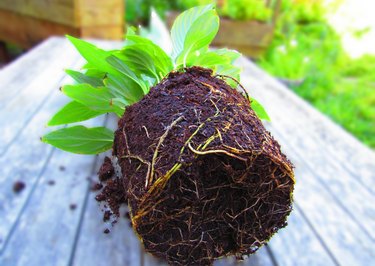
Sowing seeds just isn't worth it when it comes to propagating peace lilies. The best, quickest, and surest way to go from one peace lily to two or more is by a process called division.
To propagate:
- Remove the plant from the pot.
- Cut away the small stems growing near the main stem. Then divide the roots by simply tugging them apart. If there are no offshoots, just cut away a section of the main rootball with a few leaves attached.
- Prepare a new pot for each division. Replant in fresh, moist soil, and set in a low-light area.
- Keep the soil moist. When new growth appears, the root system is established.
Repotting Your Peace Lily
Peace lilies prefer to be a little pot-bound, so don't be too quick to repot. Plan to repot and divide every few years. This replenishes the soil.
Frequently Asked Questions
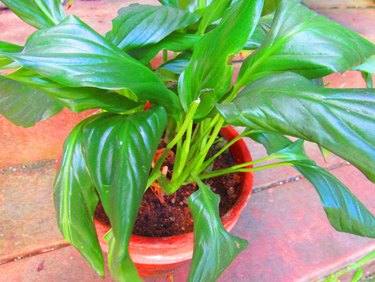
How do I get my peace lily to bloom?
The number one reason that peace lilies fail to bloom is inadequate sunlight. Move your peace lily to a site with indirect sun, and continue watering the soil when it dries out.
What if the flowers are green?
Green flowers often indicate an excess of nitrogen. This could be caused by too much fertilizer or the wrong type of fertilizer. Flowers that are small or weak looking may indicate a lack of potassium; try a fertilizer optimized for flower blooms.
Why are my peace lily leaves curling?
Peace lilies react to improper conditions by curling their leaves. This may mean too much water; it may mean too little water. I recently inherited a peace lily with severely curled leaves and discovered that the soil was extremely moist. I checked again a week later, and the soil was still moist. I had to replant in new potting soil to get the leaves to uncurl.